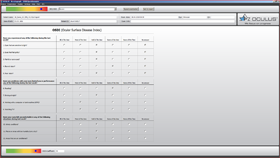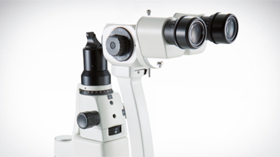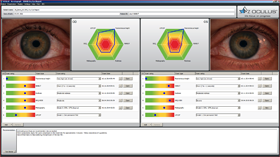NEW JENVIS Dry Eye Report
Find the cause of dry eye quickly and reliably. The JENVIS Dry Eye Report is an unique tool for doing this. After measurements are taken using the Keratograph 5M and the slit lamp, your customer/patient receives an easy-to-grasp print-out. The Dry Eye Report combines screening and consultancy.
Tools for the JENVIS Dry Eye Report – Here’s How it Works
Drawing up a comprehensive Dry Eye Report entails filling out a questionnaire, measuring the LIPCOF using the slit lamp and taking four measurements using the Keratograph 5M. Other nationally and internationally approved screening methods can be added with ease – numerous supplementary procedures ranging from eyelid blink frequency to staining are incorporated into the Keratograph 5M.
What good would a screening be without history taking? Commonly used questionnaires are incorporated into the Dry Eye Report on the Keratograph 5M.
- OSDI (Ocular Surface Disease Index)
- McM (McMonnies)
A look through the slit lamp
The slit lamp is the number one instrument when it comes to eye diagnostics. To draw up a comprehensive Dry Eye Report it is necessary to assess the LIPCOF (lid-parallel conjunctival folds). You enter the results into the Dry Eye Report on the Keratograph 5M.
Non-invasive measurements
The practical tools provided by the Keratograph 5M help you perform comprehensive Dry Eye analysis. Analyzing the level of redness using R-Scan, measurement of tear meniscus height, tear film break-up time and meibography can all be performed with ease using the Keratograph 5M. The result? A comprehensive Dry Eye Report.
TF-Scan
The tear film is assessed using either white or infrared illumination. The new high-resolution color camera makes even the finest of structures visible. In addition to NIKBUT (Non-Invasive Keratograph Break-Up Time) and measurement of the meniscus tear, the TF-Scan can also make an assessment of the lipid layer and the tear film dynamics. Tear film analysis with the OCULUS Keratograph 5M is non-invasive and is conducted without any additional tools.
NIKBUT
Assessment of the Tear Film Break-Up Time
The tear film break-up time is measured non-invasively and fully automatically. The new infrared illumination is not visible to the human eye. This prevents glare during the examination. The TF-scan presents the results in a way that is easy for you and your customers to understand.
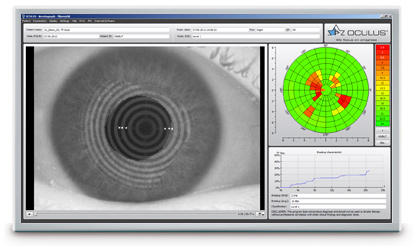
The height of the torn meniscus can be precisely measured with an integrated ruler and various magnification options, and its development along the edge of the bottom lid can be assessed. The results are saved to the patient file.
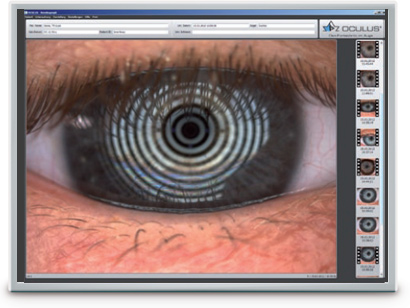
Lipid Layer: Assessment of the Interference Phenomenon
The interference colors of the lipid layer and their structure are made visible and can be recorded. The thickness of the lipid layer is assessed based on the structure and colour.
TF Dynamics: Assessment of the Particle Flow
The video recording, with up to 32 frames per second, enables the observation of the tear film particle flow, from which conclusions regarding the viscosity of the tear film can be drawn.
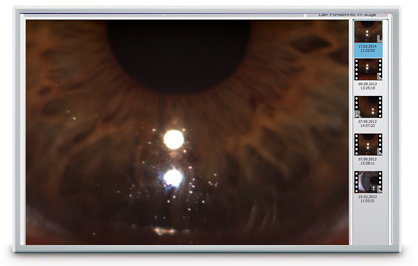
R-Scan
Automatic classification of the bulbar redness. Conjunctival redness used to be assessed subjectively and depended on the examiner. The R-Scan is the first module that automatically and objectively documents and classifies the bulbar and limbal degree of redness. The R-Scan detects the blood vessels in the conjunctiva and evaluates the degree of redness. This automatic assessment spares you the time and effort of having to make manual comparisons using classification sheets.
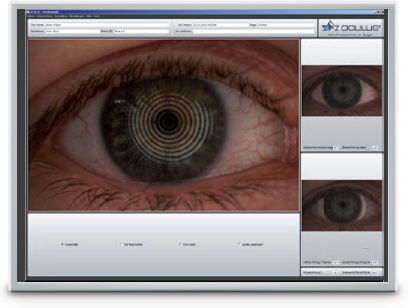
Meibo-Scan
The multi-functionality of the new Keratograph 5M enables even difficult examinations, such as Meibography, to be integrated with ease and efficiency into routine ophthalmological and optometric check-ups. A dysfunction of the Meibom glands is the most common cause of Dry Eye. The associated morphological changes in the glandular tissue can be made visible with the Meibo-Scan.
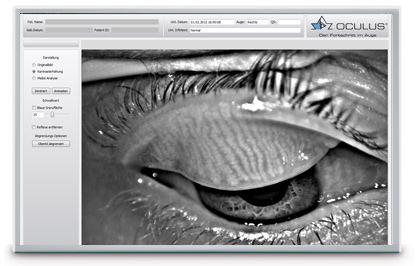
Pupillometry
- Fitting multi-focal contact lenses
- Exact determination of the treatment area for refractive surgery
- Seamless integration into the existing Keratograph software
- The infrared camera installed in the Keratograph delivers images of the patient’s pupil, which are used as the basis for the measurements
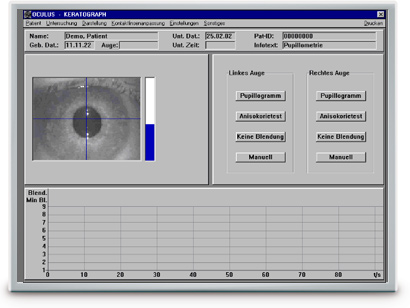
Different Ways of Determining Pupil Reaction:
- Examination of the pupil reaction both with and without glare
- Examination using two different glare stimulus powers
- Clear presentation of the results in graphic form: pupil changes over a period of time; minimum, maximum and mean pupil diameter, incl. standard deviation
- Comparison views possible
Optional Imaging-Software*
The Imaging Software is used to record video and image files. In addition to viewing the videos and single images by themselves, you can also compare the recordings with the simulated fluorescein-images of the measured eye.
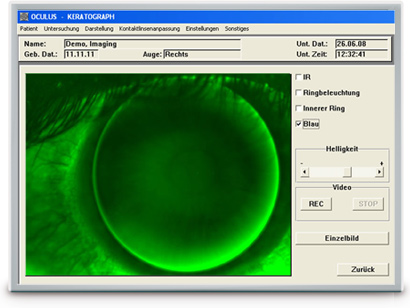
How Does That Work?
- Simply integrate the Imaging Software into the Keratograph software
- Blue light-emitting diodes in the illumination beam path stimulate the fluorescein
- Yellow filters are integrated into the observation beam path
Result: Static fluorescein-images and videos can be recorded under slit lamp conditions!
Indispensable for:
- Demonstrating the fit of contact lenses
- Assessment of the static fluo-image
- Assessment of the fit of contact lenses at different pupil sizes
- Comparison of fluo-image simulations with real-time fluo-images
- Selection of the best possible contact lens
- Consultation and customer retention
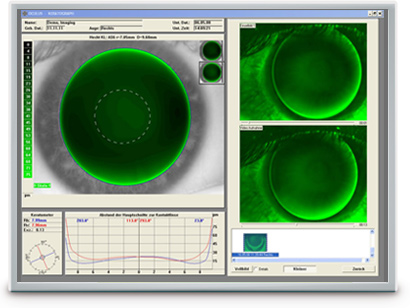
OCULUS OxiMap®
The OxiMap® presents a color map of the oxygen transmissibility of soft contact lenses based on the lens power, which is easy to understand for your patients.

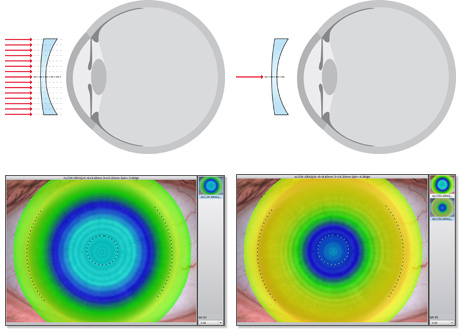
Oxygen transmissibility for a soft contact lens with the spherical power of -3.0dpt (left)/-6.0dpt (right)
Oxygen Transmissibility of Soft Contact Lenses Made Visible
An intact tear film and a good supply of oxygen to the cornea are an absolute necessity for wearing contact lenses comfortably. The OxiMap® presents a color map of the oxygen transmissibility of soft contact lenses based on the lens power – which even your customers will understand!
The oxygen transmissibility (Dk/t) depends on the material the contact lens is made of and on its thickness. In the past, only the manufacturers’ specifications about the oxygen transmissibility in the center of a -3,00 dpt contact lens were available. With the OxiMap®, you now get a graphic visualization of the Dk/t values over the whole area, based on the lens thickness.
The Dk/t values are color-coded, whereby black represents an oxygen supply lower than that present in a closed eye. To preserve the integrity of the cornea when wearing contact lenses, minimum Dk/t values are recommended based on the length of time the contact lenses are to be worn. The OxiMap® color-coding is based on these international recommendations.
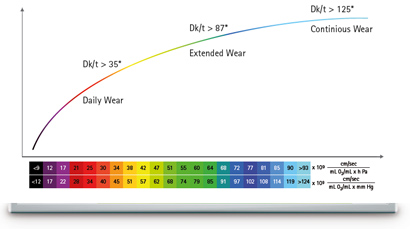
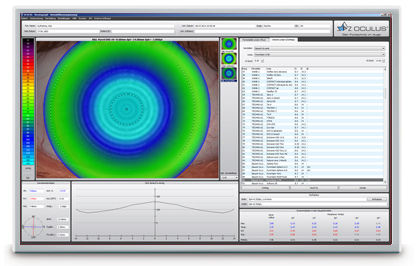
Compare Different Soft Contact Lenses!
The OxiMap® is individually adapted based on the lens power and supports you in your consultation with the patient and helps you to choose the most suitable contact lens. New materials used for soft contact lenses provide excellent oxygen transmissibility.
OxiMap® was developed in close cooperation with JENVIS Research and the University of Applied Sciences in Jena.
